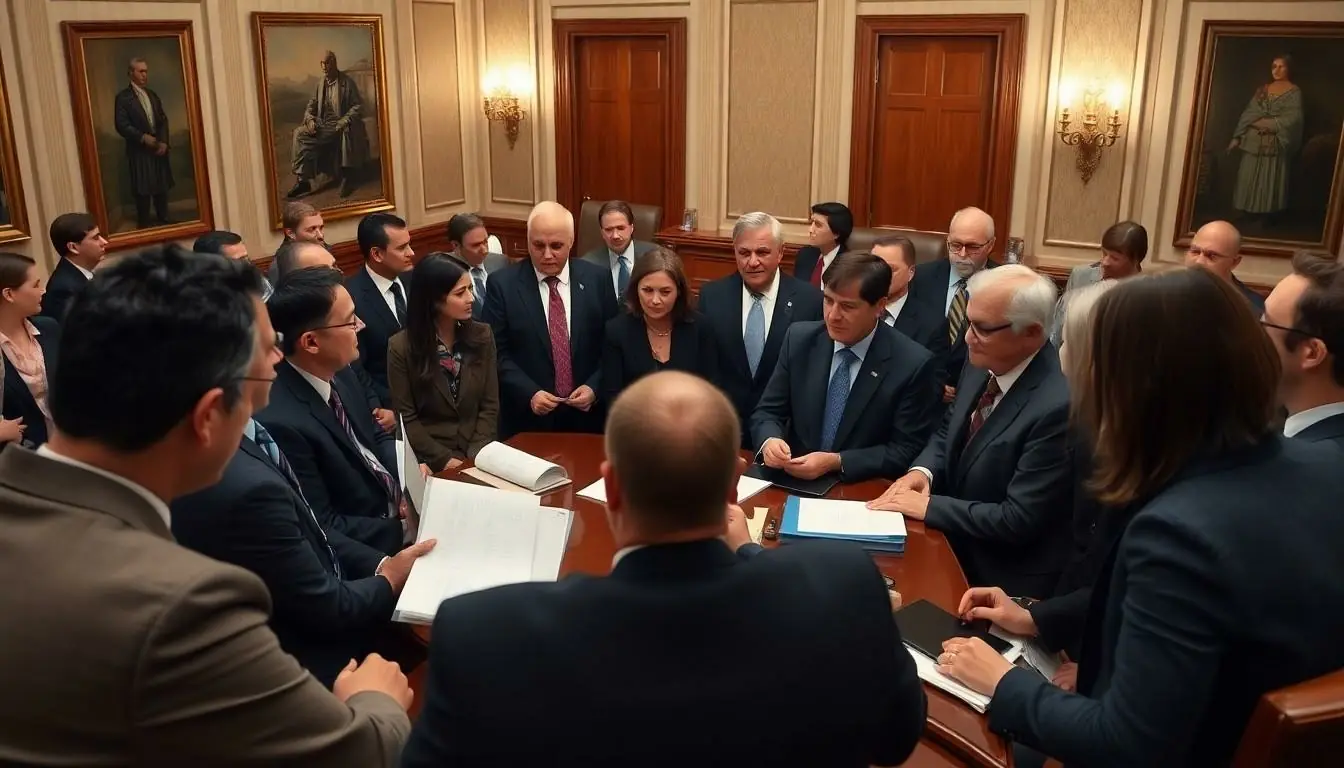In a world where the latest health trends can feel as fleeting as a TikTok dance, alternative medicine is making a stand on Capitol Hill. Imagine lawmakers trading in their suits for yoga pants and herbal teas while debating the merits of acupuncture and aromatherapy. It sounds like a scene from a quirky sitcom, but the reality is that alternative medicine is gaining traction among politicians and constituents alike.
Table of Contents
ToggleOverview of Alternative Medicine on Capitol Hill
Alternative medicine has gained traction among lawmakers. Acupuncture, aromatherapy, and other holistic practices are becoming part of legislative discussions. Politicians showcase a growing interest in these methods, recognizing their potential benefits for constituents. Regular meetings and forums now feature alternative health advocates, reflecting their integration into political discourse.
Shifts in public opinion drive this trend, as constituents increasingly seek natural remedies alongside conventional treatments. Evidence supports practices like acupuncture for pain management and stress relief, aligning with wider healthcare trends. Committee hearings have included testimonies from practitioners, signaling recognition of alternative medicine’s legitimacy.
Many lawmakers visit holistic health centers, illustrating personal commitment to exploring diverse health solutions. They also engage with organizations advocating for alternative therapies, creating partnerships that promote awareness. Bills focusing on insurance coverage for alternative treatments are emerging, pointing to a significant shift in healthcare policy.
Scientific research on alternative medicine has influenced legislative attitudes. Studies published in reputable medical journals provide data on efficacy, driving interest among lawmakers. Increased dialogue facilitates collaboration between traditional and alternative healthcare providers, fostering a more comprehensive approach to patient care.
Consumer demand further impacts the political landscape. Polls indicate that a majority of Americans favor insurance coverage for alternative therapies. As politicians respond to these requests, legislative measures may evolve to incorporate alternative medicine as a standard healthcare option.
Historical Context

Alternative medicine has developed a notable presence on Capitol Hill, reflecting changing attitudes toward holistic health practices. Increasingly, lawmakers engage with practices like acupuncture and aromatherapy, acknowledging their relevance in contemporary healthcare discussions.
Early Legislation
In the 1990s, the National Center for Complementary and Integrative Health emerged, focusing on scientific research for alternative therapy. Legislation during this period marked the beginning of formal recognition for these practices within healthcare frameworks. Later, various bills sought to improve insurance coverage for complementary therapies, echoing an evolving understanding of patient needs. Legislative interest grew as public demand for natural remedies surged, shaping policies that integrate alternative medicine into standard healthcare options.
Key Figures in Alternative Medicine Advocacy
Prominent advocates have played a crucial role in advancing alternative medicine on Capitol Hill. Politicians and health professionals alike, they raise awareness through consistent engagement with holistic health organizations. Figures like Senator Tom Harkin championed the inclusion of complementary therapies in federal health initiatives. Their efforts reflect a concerted push for policy changes that align with public sentiment. Increased communication between traditional and alternative practitioners showcases a shift toward a more inclusive healthcare dialogue, reinforcing the importance of varied health approaches.
Current Trends and Developments
Alternative medicine continues to gain traction on Capitol Hill, with lawmakers exploring new policies and discussions around holistic health practices.
Recent Policies Impacting Alternative Medicine
Recent legislative efforts reflect an increasing recognition of alternative medicine’s place in healthcare. New bills seek to expand insurance coverage for treatments like acupuncture and herbal therapies. Senator Tom Harkin’s advocacy has been instrumental in this movement, driving proposals that prioritize complementary therapies. Polls indicate over 70% of Americans support insurance coverage for alternative treatments, prompting policymakers to act. Additionally, the Department of Health and Human Services is exploring guidelines to integrate these practices into mainstream healthcare. These developments signal a shift toward more inclusive health policy.
Congressional Hearings and Discussions
Congressional hearings have become vital forums for discussing alternative medicine. Prominent legislators invite health experts and practitioners to share insights on the efficacy of complementary therapies. Recent discussions highlighted the benefits of acupuncture and mindfulness in pain management, reflecting widespread public interest. Bipartisan support has emerged, indicating a collective acknowledgment of alternative practices’ potential. Advocacy groups actively participate, aiming to inform legislators on the scientific basis of these therapies. Engaging in these dialogues fosters collaboration between traditional and alternative health sectors, shaping future healthcare policies.
Challenges Facing Alternative Medicine
Challenges exist for alternative medicine’s growth on Capitol Hill. Both skepticism and regulatory barriers hinder broader acceptance and integration.
Scientific Skepticism
Skeptics often question the efficacy of alternative medicine. Evidence supporting these practices frequently remains limited, making it challenging for lawmakers to advocate for such treatments. Scientific studies yield mixed results, leaving room for doubt among traditional healthcare providers. Critics argue that a lack of rigorous research compromises the credibility of alternative therapies. Furthermore, this skepticism can shape public opinion, affecting the support for legislation aimed at expanding coverage. A call for more comprehensive scientific research on these modalities continues among proponents, suggesting that only through rigorous studies could alternative medicine gain substantial legitimacy.
Regulatory Hurdles
Regulatory hurdles complicate the advancement of alternative medicine. Approval processes for these therapies can be lengthy and expensive, creating barriers for practitioners seeking to establish their practices. Current insurance frameworks often exclude alternative treatments, adding financial strain on patients. Compliance with existing healthcare regulations can also prove challenging for practitioners of alternative therapies. Legislative efforts may focus on creating pathways for integration, yet progress remains slow. Federally funded research plays a role in overcoming these obstacles, potentially informing new regulations that could foster acceptance and reduce barriers down the line.
Future Outlook
Alternative medicine on Capitol Hill shows promise for continued growth and integration within mainstream healthcare.
Potential Changes to Legislation
Legislative changes may enhance coverage for alternative therapies like acupuncture and herbal treatments. As awareness expands, more lawmakers recognize the demand for insurance that includes these services. Bills aimed at providing better access to complementary therapies could emerge from ongoing discussions. Polls indicate that over 70% of Americans support such measures, influencing politicians to take action. The evolving dialogue may lead to formal proposals addressing gaps in current insurance frameworks. Increased support from advocacy groups also pushes lawmakers to consider expansive legislation focused on integrating holistic practices.
Advocacy Efforts Moving Forward
Advocates for alternative medicine maintain momentum in promoting its benefits on Capitol Hill. Key figures, such as Senator Tom Harkin, continue to push for policy changes that reflect public support. Collaboration between alternative practitioners and traditional healthcare providers strengthens these advocacy efforts. As consumer interest grows, advocates are likely to organize more forums discussing alternative therapies. Research backing these practices provides solid evidence to sway skeptical lawmakers. Engaging with public health organizations is essential for promoting a more inclusive healthcare dialogue. Continued efforts may significantly impact future legislation shaping the landscape of alternative medicine.
The rise of alternative medicine on Capitol Hill marks a significant shift in how lawmakers view holistic health practices. As public demand for natural remedies grows, politicians are increasingly engaging with these therapies, reflecting changing attitudes in healthcare.
Key advocates like Senator Harkin are driving this movement forward, promoting policies that could enhance insurance coverage for alternative treatments. While challenges remain, including skepticism and regulatory hurdles, the momentum suggests a promising future for the integration of alternative medicine into mainstream healthcare.
With ongoing research and advocacy efforts, the landscape of health policy is likely to evolve, paving the way for a more inclusive approach that recognizes the benefits of diverse healing practices.





